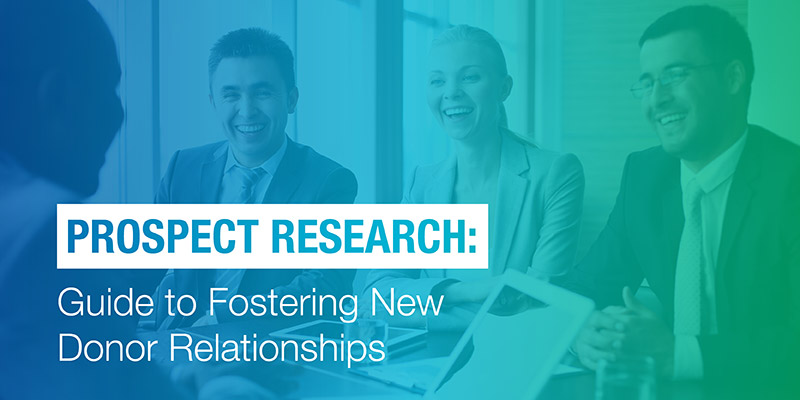While every nonprofit wants to retain donors, they also want to grow. By cultivating new relationships with donors, your organization can find major supporters to help fund your core projects.
Growing your community of supporters is never a bad thing; the more connections you have, the more awareness you can spread!
Organizations looking to find new donors will need to consider their prospect development strategies and utilize their donor data to its maximum potential.
Luckily, we have five strategies to help you foster new donor relationships using prospect research:
- Determine your key objectives.
- Identify prospect research tools.
- Keep donor data clean and up-to-date.
- Take advantage of existing connections.
- Develop a cultivation plan.
With these essential prospect research strategies under your belt, you’ll be able to not only find new donors but also build lasting and supportive relationships with them.
1. Determine your key objectives
Pinpointing the reasons why your organization wants to foster new donor relationships will impact what you look for in your prospects, what prospect research tools you use, and how you build your cultivation plan.
For instance, you might be interested in finding new donors because you want to grow your pool of volunteers. Looking into prospects that already have a history of donating their time to other organizations will be the best way to find potential volunteers for your nonprofit.
Another more common reason you might be interested in building relationships with new donors is to find new major supporters through prospect research. If that’s the case, your best bet will be to examine your current supporters before researching potential donors.
As you can see, the way you approach your prospect research will depend on your core goals and objectives. Meet with your team of executives and prospect researchers (or consultant if you’re using an third-party prospect research service) and ask the following questions:
- Why are we looking to build new donor relationships? Are you looking to find new major donors, grow your donor base, spread more awareness about your cause, etc.?
- What types of donors are you looking for? Should we look for prospects that have a high giving capacity, history of past philanthropic behavior, or a combination of both?
- What data should we know about our prospects before reaching out? Is it important for your team to know what organizations prospects contributed to last or if they have a history with a similar cause?
- What do we want from our prospects? After developing a relationship, do we want prospects to contribute, volunteer, join our board of directors, or do something else?
Clearly defining your goals and creating a blueprint of the types of prospects you’re looking for will make the next stages in your process much easier.
2. Identify prospect research tools
Now that you’ve got goals to help focus your research, it’s time to look at what tools you’ll use to find prospects.
Whether you’re conducting the research in-house or hiring a consultant to do it for you, charitable giving databases are the first place you should look.
Nonprofits have access to a number of public databases that focus on key data points like a prospect’s political contributions, wealth, and professional background. Here are just a few that your nonprofit can look into:
- The Chronicle of Philanthropy is an online resource that lets organizations research prospects by location. Nonprofits will have access to some of their data for free, but to access most of the information, you will be required to pay a yearly subscription.
- FEC (Federal Election Commission) Filings provides information on a donor’s political giving. Just enter a prospect’s name, and you’ll be able to see if they gave to a political committee or campaign.
- The Million Dollar List is a free list of contributions of at least one million dollars. The list includes donations made as far back as 2000 and can be filtered by donor, recipient, or location.
In addition to prospect research databases, looking at nonprofit annual reports can offer a wealth of information about potential supporters.
Think about it: annual reports often highlight major donors, mentioning how much they contributed to the nonprofit and what projects the money was donated to.
Look at the reports of organizations that have similar (but not exactly the same) causes or that operate in the same area to see if you can identify potential major supporters.
Using the connections that donors already have—whether it’s through previous campaigns they’ve supported or a community they’re passionate about helping—can be a great way to introduce your cause to prospects.
While all of these tools can offer deeper insights into your prospects, using a comprehensive charitable giving database, like DonorSearch, for example, provides a more comprehensive look at your donors.
Our database grabs information from public and private databases as well as nonprofit annual reports to help give you a well-rounded picture of a prospect’s philanthropic history, all in one location.
3. Keep donor data clean and up-to-date
As you begin conducting prospect research, all the data you find will need to go somewhere—and the most likely spot is your nonprofit’s CRM.
Building up your prospect profiles is essential when it comes time to analyze the data you’ve collected.
Cleaning out and updating your donor data is an important prospect research strategy as well as a more general best practice. After all, organized and clean data is most effective for your team.
The first step to better donor data is to regularly “spring clean” your database. By “spring clean,” we mean going through your data and removing any duplicate accounts, making sure data is standardized throughout your system, and updating constituents’ personal information.
If you don’t check your database often already, that’s okay. There’s no better time to start than the present!
Next, you’ll need to create a standard process for how team members input information. That way, no matter who enters the data, anyone on your team will be able to locate it.
Moreover, standardizing your data means it will be a lot easier to understand when it comes time to pull fundraising reports to analyze for your cultivation plan (which we’ll cover later).
4. Take advantage of existing connections
Once you’ve compiled a list of potential donors, you need to start thinking about how you’re going to reach out to them. The first thing you should do is look at your existing supporters to see if they have any connections to prospects.
If you’re looking for major donors, this step is especially important. A prospect is much more likely to hear your nonprofit out if someone they know recommends you first.
When looking at your supporters’ connections look for links, such as:
- Colleges or universities. If you know where your prospect went to school or was part of a sorority or fraternity, look at your donor database to see if you have any supporters with the same alma mater.
- Philanthropic activity. Have any of your board members or major donors served on a board with the prospect?
- Clubs and associations. Perhaps your prospect is a member of the local golf club or business association. Look to see if any of your supporters are part of the same group.
- Employment. Look to see if any of your major donors work for the same company as your prospect.
- Personal relationships. Don’t forget about personal ties as well. You may find that one of your donors is a close friend or family member of your prospect.
As you can see, knowing detailed information about your prospects that goes beyond their philanthropic history will be vital at this stage.
That’s why, your team shouldn’t discard any information about your prospects; it might become useful when you look for connections or reach out for the very first time.
5. Develop a cultivation strategy
Now that you’ve established your goals, used prospect research to identify your donors, and looked at potential connections in your current donor database, it’s time to put all this information to use.
Your cultivation strategy should focus on how you plan to reach out your prospects and what you want to say.
First, begin with an initial introductory meeting. If a major donor or board member already has a connection to your prospect ask them to set up a short, 30-minute coffee conversation. They should discuss your organization’s mission, future plans, and end the meeting by asking the prospect if they’d be interested in getting involved.
Don’t have an existing connection you work with? Try inviting the prospect to an upcoming fundraising event. This way, they’ll get to see your nonprofit in action as well as speak with volunteers and team members during the event.
Once a prospect has expressed interest in getting involved, continue to communicate with them through various meetings, such as:
- Inviting them to tour your facility.
- Asking them to volunteer.
- Regularly checking in via phone call.
- Inviting them to an event.
Finally, after engaging with your prospect using multiple opportunities, make your appeal.
Incentivize prospects by telling them about corporate giving opportunities. Programs like matching gifts and volunteer grants make it easy for supporters to contribute twice (even three-times) as much funds to your organization.
If you know a prospect works for a company with a great volunteer grant program, tell them!
Your appeal should also include information about how the money will be used and the positive impact that their donation will have on your organization.
Fostering new relationships can be difficult and time-consuming, but it’s worth it if your nonprofit wants to grow and continue serving the community.
With these five prospect research strategies, you can identify the right prospects and use your research to find the best path for reaching out to potential donors.
Author Bio

Sarah Tedesco is the Executive Vice President of DonorSearch, a prospect research and wealth screening company that focuses on proven philanthropy. Sarah is responsible for managing the production and customer support department concerning client contract fulfillment, increasing retention rate and customer satisfaction. She collaborates with other team members on a variety of issues including sales, marketing and product development ideas.

